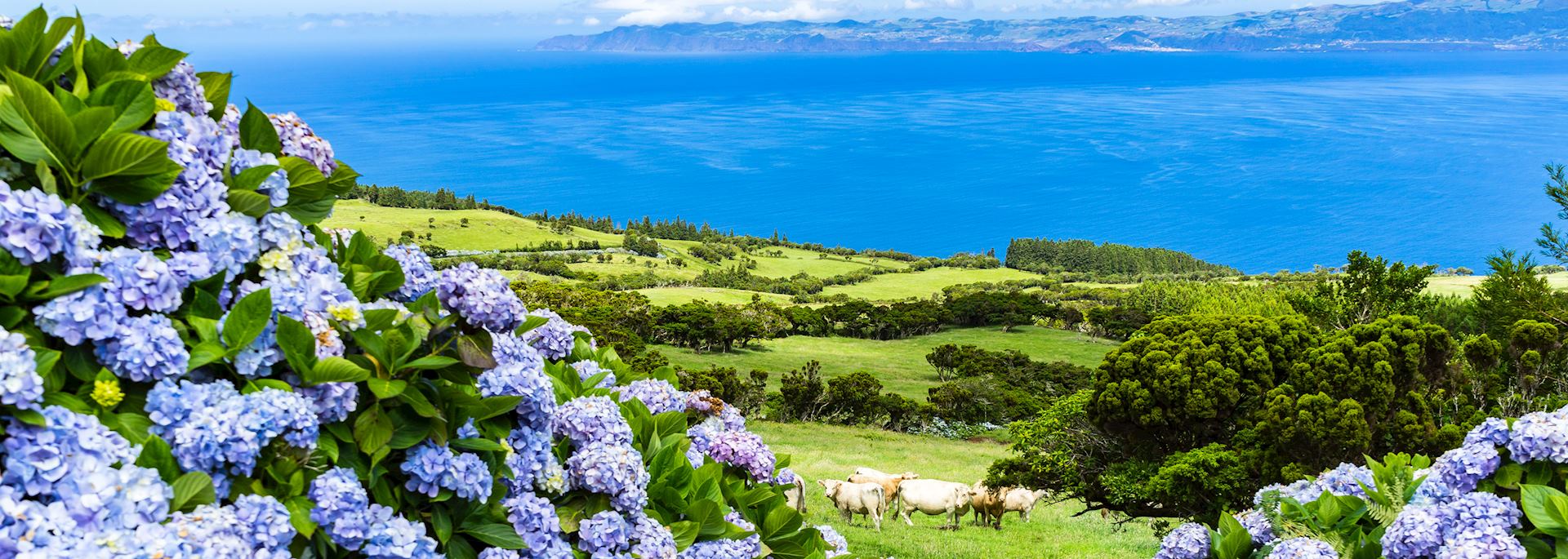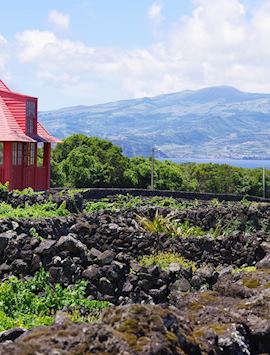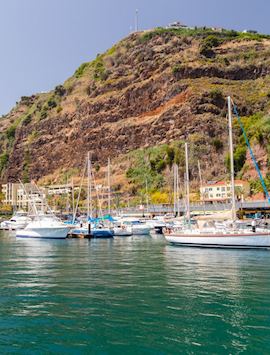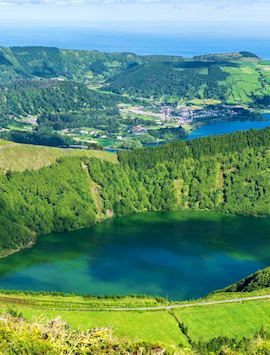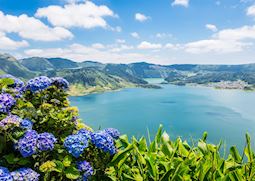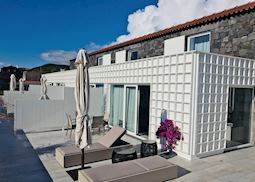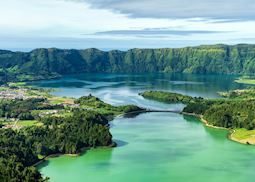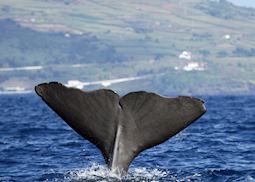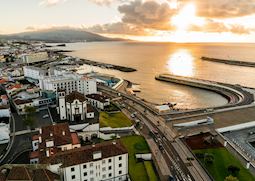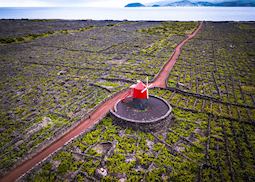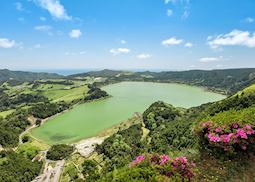Jump to:
Surrounded by nothing but the churning waters of the Atlantic Ocean for hundreds of miles, the Azores may be an autonomous region of Portugal but the archipelago offers a vastly different experience to the mainland. These nine volcanic islands each have their own character, from the lush hills of São Miguel to the towering volcano and stone-walled vineyards of Pico. Hiking, cycling or driving the quiet roads, you’ll come across waterfalls, hot springs, steaming fumaroles, lush meadows and cerulean lakes, while offshore, whales ply the waters. Hop between islands on short flights, explore the dramatic landscapes and enjoy the islands’ laid-back lifestyle.
Things to see and do in the Azores
The Azores’ natural bounty
Although the Azores appeared on nautical charts from the 14th century, the uninhabited volcanic archipelago was only officially discovered and settled by the Portuguese and Flemish in the 15th century. The rich volcanic soil and freely available water sources meant the settlers prospered and were soon exporting wheat and plant dyes to mainland Europe and Africa. Their livestock thrived too and today the island of São Miguel produces almost 30% of Portugal’s milk. Endemic plant species provide scientific and botanical interest, geothermal energy is used to cook food, and you can sample an array of local wine, cheese, honey and pineapples.
São Miguel
The largest of the nine islands, São Miguel is known as the green island because of its lush hills and verdant fields, including Europe’s only tea plantation. The island is home to the regional capital, Ponta Delgada, where you can find Baroque architecture, botanical gardens and an ocean swimming pool.
Explore the geothermal wonders of Furnas, a dormant volcanic caldera where bubbling mud pots, steaming fumaroles and hot springs offer the chance to soak in thermal pools, kayak across the lake or eat cozido, a traditional stew, cooked underground. Or hike around the blue and green lakes at Sete Cidades for sweeping views.
Terceira
The third of the islands to be discovered, Terceira, the purple Island, is blanketed in hydrangeas and was briefly the only independent part of Portugal. The island’s capital, Angra do Heroísmo, was an obligatory port of call for transatlantic fleets between 15th and 19th centuries — most of the city is built around its two ports in a series of streets lined with historic churches, convents, mansions and gardens.
Beyond Angra, the island offers lots of good hiking, especially on the volcanic Monte Brasil and through the dense forests and ancient lava flows of Mistérios Negros.
Pico
Littered with volcanic stone and home to the Azores’ highest peak, Pico is best known for its vineyards which are contained within a network of stone walls that absorb the sun’s rays by day and release it by night. Franciscan priests first brought Sicilian grapes to the island in the 15th century and wine and liqueur production has become an important part of the local economy.
Elsewhere, you’ll see traditional Flemish windmills, old lava flows known as mistérios once attributed to divine retribution by the Catholic islanders, and the world’s longest lava tube, Gruta das Torres.
Faial
Known as the blue island thanks to its deep-blue hydrangeas, Faial’s location in the heart of the Atlantic has made it a popular stop for transatlantic sailors and a hub for communications companies. Horta, its main town, has a lively cosmopolitan atmosphere and is home to Peter’s Café Sport, a legendary, family-run place that has fed, watered and supported sailors since 1918.
Faial is best known perhaps for the eruption of the Capelinhos volcano in 1957, which buried a whole village and considerably increased the size of the island. You can explore the area around the crater for sweeping views.
São Jorge
Formed by a series of volcanic eruptions that left this long, slender island pitted with craters and dotted with volcanic peaks, São Jorge is reminiscent of a dragon rising out of the ocean. The island is fringed by fajãs, lava deltas that extend into the sea — over time, small communities have developed on the fajãs, some only accessible on foot.
Although it is known locally as the brown island thanks to its dramatic cliffs, its verdant hills offer scenic walking and a chance to see coffee plantations and the island’s renowned cheese producers at work.
Best time to visit the Azores
The Azores are at their best between April and May when you’ll be treated to pleasant temperatures and carpets of flowers blooming across the hills. It’s also the best time of year to go whale watching. July and August bring higher visitor numbers, and prices. Whenever you visit, be prepared for fickle weather with cloudless skies liable to change at any minute.
who's been there
-
01993 838 92501993 838 461
- Make an enquiry
Suggested itineraries featuring the Azores
Our itineraries will give you suggestions for what is possible when you travel in the Azores, and they showcase routes we know work particularly well. Treat them as inspiration, because your trip will be created uniquely by one of our specialists.
Our expert guides to exploring the Azores
Written by our specialists from their own experiences of visiting the Azores, these guides will help you make the most of your time there. We share both our practical recommendations and the best ways to appreciate the Azores at its best.
-
The best things to see & do in the Azores ![Sete Cidades, São Miguel]()
The best things to see & do in the Azores
The best things to see & do in the Azores
A clutch of volcanic islands in the middle of the Atlantic, the Azores boast a vast array of landscapes. Portugal team member Corinne discusses highlights of the archipelago, including cheese and wine tastings and a volcano that emerged in the 1950s.
Read this guide
Accommodation choices for the Azores
We've selected a range of accommodation options for when you visit the Azores. Our choices usually come recommended for their character, facilities and service or location. Our specialists always aim to suggest properties that match your preferences.
-
![Vinhas do Calhau]()
Vinhas do Calhau
Azores -
![Terceira Mar Hotel]()
Terceira Mar Hotel
Azores -
![Furnas Boutique Hotel, Sao Miguel]()
Octant Furnas Hotel
Azores -
![Azor Hotel, Sao Miguel]()
Octant Ponta Delgada
Azores
Ideas for experiencing the Azores
Our specialists seek out authentic ways to get to know the places that could feature in your trip. These activities reflect some of the experiences they've most enjoyed while visiting the Azores, and which use the best local guides.
-
Sete Cidades 4x4 and cycling tour ![Twin lakes, Sete Cidades, São Miguel]()
Sete Cidades 4x4 and cycling tour
Sete Cidades 4x4 and cycling tour
Explore by 4x4 and bike to get far-reaching views of the enormous caldera at Sete Cidades as well as a more personal introduction to this unusual landscape, its history, legends and lakes as well as the volcanic activity that shaped it.
View details -
Whale and dolphin watching in the Azores ![Sperm whale, Pico]()
Whale and dolphin watching in the Azores
Whale and dolphin watching in the Azores
Explore the deep waters off the Azores on this half-day whale and dolphin watching tour in an area where about 25 different species, from blue whales to humpbacks and orcas, are frequently seen.
View details -
Ponta Delgada walking tour ![Aerial view Ponta Delgada, São Miguel]()
Ponta Delgada walking tour
Ponta Delgada walking tour
Tour the narrow, cobbled streets of Ponta Delgada, the capital of the Azores, with a local guide. Learn about its foundation, architecture and defences and its heyday in the 18th and 19th centuries when wealthy merchants constructed imposing Baroque buildings.
View details -
Hiking Pico’s wine region ![Windmill, Criação Velha, Pico]()
Hiking Pico’s wine region
Hiking Pico’s wine region
Take a guided walk around the UNESCO-protected vineyards of Pico, an island cultivated with vines since the 15th century. Learn about the history of viticulture here and the unique growing conditions before sampling local wines at the island cooperative.
View details -
Kayaking at Furnas Lagoon ![Furnas Lagoon, São Miguel]()
Kayaking at Furnas Lagoon
Kayaking at Furnas Lagoon
A crater lake cradled by a dormant volcano, Furnas is surrounded by lush hills, geothermal fields and small villages. Paddle around the lake with a local guide to learn about its volcanic heritage as well as its plant and animal life.
View details

